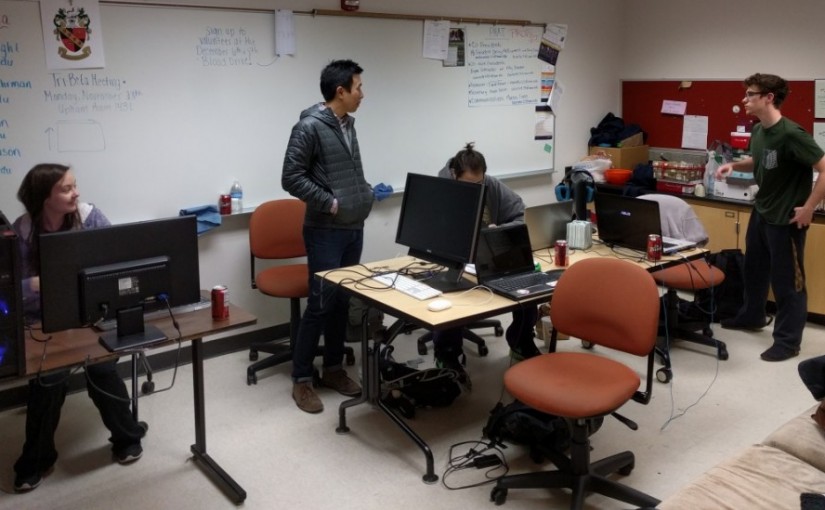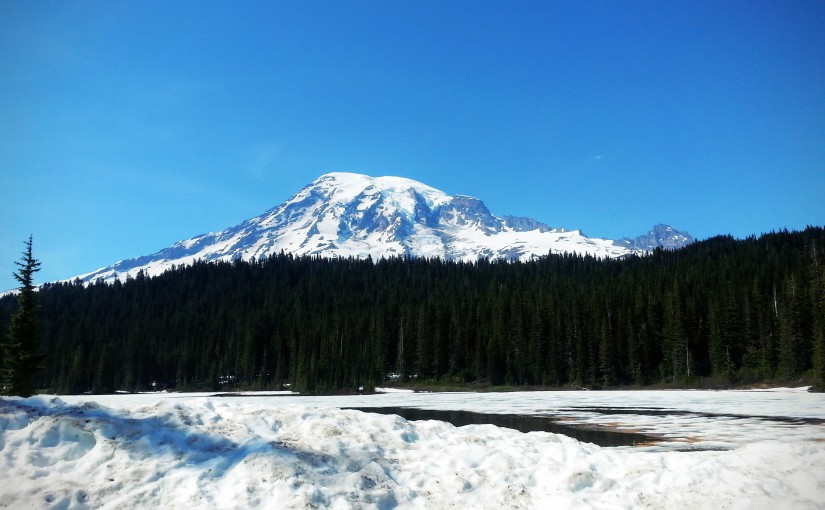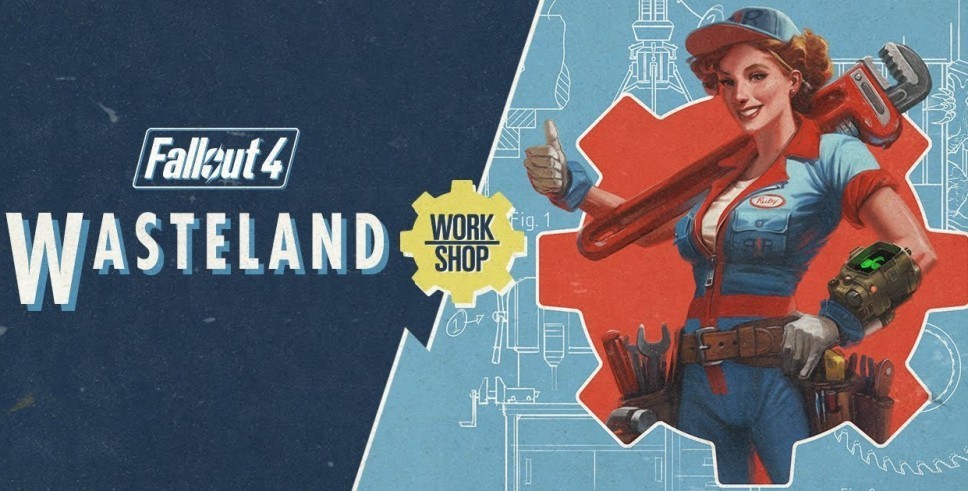So, I thought it would be nice to share some relevant content that caught my interesting. I recently came across this interview with Bethesda Softwork’s director and executive producer that give great insight into Bethesda as a studio as well as the process of game development and how things work on the larger scale part of game development. You can find a link to the interview below.
Month: November 2016
Game Jam: UWW 2016 Hackathon
Bleh, it has been a long road from the start of the Hackathon to typing at my keyboard about the event. This was my first game jam and I was awake a full 24 hours (and beyond), I got sick, and wrecked my sleeping schedule all in order to make a game that only ended up being partially finished. I wouldn’t change a thing. Even with all of its drawbacks, the experience was extraordinary and I wouldn’t trade it for anything.
Forgive me if this post is a little rambly and all over the place and less professional than some of my other posts. I’m still dealing with the aforementioned sickness and lack of sleep which, surprise! Makes it really hard to think straight.
Anyways, the beginning is probably the best place to start. Our team consisted of 3 programmers/designers, a narrative designer (me), and a visual artist. We trekked together over the hall in which the event was being held and set up all of our computers and various equipment in one of the rooms. We brought a coffee machine which proved to be an excellent morale booster. Anyways, the premise for our game was a series of short and easy to understand mini-games that up to four players could pick up and play. We started with an original goal of making 10 mini games, but ended up scaling back to 5, and then down to 3 games as our deadline grew nearer and we continually ran into various problems or issues that bogged down progress. The programmers tell me that the back-end programming, as well as programming for 4-players, was a real pain.

The game was called Mini Mages and its narrative premise was that of four novice mages applying for an apprenticeship with a renowned grand mage. A lot of the content I had written for the game didn’t make it due to time constraints, but that’s just game development. Things will always have to be cut for the sake of deadlines and or other restrictions. Speaking of restrictions one of the ones I found challenging while writing for the game was my restriction on the length of content. We wanted the game to feel fast-paced and frantic and we wanted to use a typewriter effect that scrolled text in. Combined with the limitation of having the screen with text appear for a limited amount of time to keep with the quick pace of the game all of my written content had to be around 100 – 120 characters. Not words, characters! My skills to write with brevity were pushed to limits. (Unlike now where I’m just spewing info at you.) It was hard, but it got done eventually. After that, I spent the rest of the night supporting the real heroes (our programmers and visual artist) by looking for free audio we could use, due to a lack of time to create our own, and by making sure everyone was stocked with snacks, coffee, and energy drinks.
Anyways, long story short it was a lot of fun. We made 3 mini games for our game and we got 3rd place out of the other competitors. All in all, not a bad day/night.
I’d highly encourage you to look for game jams in your area and or create your own. They’re great fun especially when you’re surrounded with your friends and working on something that you are all greatly passionate about.
Now I am going to resume sleeping in hopes that eventually I’ll wake up without a headache or feeling sick in general.
P.S. Still worth it
By the way here is the video of our presentation:
https://www.youtube.com/watch?v=SHdUVcHGy7g
Game Jam: Hackathon
You’ve probably noticed a lack of content on the blog for this week and are missing your usual Friday content. We’ll worry not, it’ll be coming just a little later than expected. I’m going to be participating in an event on my campus called a Hackathon. It is essentially a game jam, but it offers slightly wider options on what you can produce. Any kind of software is acceptable including apps, programs, and games.
Over the course of 17 hours starting at 6pm my time we’re going to be hard at work trying to create a game and I’m going to try and document some of the experience for you all in a feature article of sorts. I might try making some more video content for the event as well. We’ll see what I have when it’s all said and done.
So in essence, that’s why our regular content will be a little later than expected this week.
Before I go to get prepped for the event I’d highly encourage you to try and start an event like this in your area or community or join one of the many online game jams that you can find across the net.
The global game jam is coming up January 20th and would be a great game jam to participate in. Events like these give budding designers experience, team-building, and the ability to network with other designers and are a great resource. Definitely, don’t miss out on them if you have the opportunity.
Game Vlog: Bethesda & World Design
I decided that it would be nice to branch out and try delivering content in a video format. I’m very new at recording and the whole process of creating and narrating video content. So, if you have any thoughts or suggestions please let me know in the comment section below. And now with no further introductions, I present you with The Game Libary’s first video:
https://www.youtube.com/watch?v=FHWn4DSrTbY&feature=youtu.be
Game Blurb: Do All The Things!
written by Ian Hertzberg
Okay, so this is going be a short and sweet post, but an important one none the less. Do all the things! Seriously, do stuff lots of stuff. Learn stuff, go places, see things, it is incredibly important that you do. Why? Because knowing more and having experienced more give you more to draw on when making a game.
If you read my article about experiences (if not check it out: here) then this should be starting to sound a little familiar. Tons of game designers draw on personal experience when making work. Experiences that the designers went through or felt physically or emotionally have helped create truly great games, but you can’t have those experiences to draw on if you don’t have many experiences.
That being said, learning is an experience too and learning a little about a lot of different subjects can really help to inspire your designs. When I write fiction mythology, world history, and culture have a huge influence and inspire me on a regular basis.
So, what I’d urge you to do is go out into the world like it was some sort of open-world RPG sandbox and interact with it. Travel to new places, taste new food, meet new people, do something new, have experiences. It’ll help you grow as a designer and it’ll help you grow as a person too.
Also, if you think that learning more about mythology and classical literature would be a cool way to expand your knowledge then I highly recommend giving Overly Sarcastic Productions a look. They’ve got great summaries of classical literature and myth with an extra dose of humor and wit. Seriously give them a look.
As always feel free to leave a comment below and let us know what’s up. I’m always interested in the thoughts and opinions of others.
Game Blurb: World Design & Fallout 4’s Settlements
written by Ian Hertzberg
So, do you own a copy of Fallout 4? Chances are that you do; it sold pretty well. If so, you can use it to practice a little bit of game design and chances are you already have. Fallout 4’s settlement mode is a great tool for practicing a little bit of world design. The mode allows you to place various objects and create various structures within a set area as well as populate these area’s making them a place to live. If you’ve been using the settlement system you’ve been practicing world design without even knowing it. Neat, right!?
But how can you learn even more from Fallout 4’s settlement mode? By using it knowingly. When you’re building settlements incorporate design philosophy into your builds. A good place to start is by analyzing how Bethesda has created a lot of other areas in Fallout 4. Pay attention to the aesthetics of the design. Most of the buildings look fairly ramshackle and poorly built. This is a post-apocalyptic setting after all and the people living in the wasteland don’t have access to proper tools or equipment and have to make do with what they have. So, maybe you could try and mimic that kind of design philosophy yourself throughout your various settlement builds. For instance, if you’re building in a settlement that’s near a train yard maybe you could use train boxcars as part of your design, maybe you could turn those boxcars into shops and home for various settlers. Near a location that contains a lot of demolished cars? Then maybe try building structures out of old tires and scrap metal.

With a design philosophy pertaining to realism, you would want to think about what objects make up the structures in your settlement, how your settlers got those items, and how practical their use would be. I, for instance, tend to build walls around my settlements using elements of resources prevelant in the surronding areas. For example, at the Red Rocket Gas Station settlement, I used buses and truck trailers to make up portions of the wall surrounding my settlement I then made the inside of these settlements double as a home as I could see my settlers using them as such. But, that’s just using a design philosophy built around realism in terms of the world you’re building in. I could think of a couple other philosophies you could use when building a settlement, such as one based around making outlandish and unique structures, or another design philosophy based solely on how much utility and function structures provide your settlers.

I tend to like the idea of designing with realism in mind because of the limitations and challenges it puts on building things and I think it is a great exercise in world design. If you’ve played a lot of previous Bethesda Softworks styles you’ll notice that they have a ton of really believable areas in their world because they do think about the overall environment and the world their building in, but that is an article for a future date.

P.S. One more tip for Fallout 4’s settlement mode before I go. Try not to overuse a particular asset if you can. Too much of one asset repeated over and over tends to break the overall vibe of realism and doesn’t have nearly as much aesthetic appeal as something that uses variety. If you’re looking for tips on building Fallout 4 settlements in general, I highly recommend checking out the youtube channel: No Respawns. He does a great job at creating some believable and innovative settlements.
So go out and give building a settlement using a design philosophy a try also if you like the kind of content I’m putting out feel free to leave a comment below.



